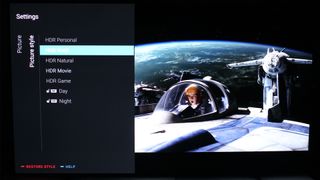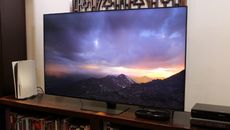There’s a fine line between art and science when it comes to picture processing, even in the very best TVs: over-cranked enhancement may be a turn-on for techies, but the end result is often difficult to watch for the rest of us.
The good news is that Philips seems to have found the sweet spot with its latest P5 picture engine. This second generation processor boasts 50 per cent more horsepower than its predecessor, and can make regular standard dynamic range HD look almost as good as 4K HDR.
So is the 803 the OLED TV enthusiasts have been waiting for? I've been bingeing on my favourite shows to find out.
- An even better Philips TV, the 903, was fully revealed at IFA 2018
- The best TV under £1000 - affordable 4K options
- Best television under £500 - much cheaper, not much worser
Philips 55OLED803 4K OLED TV: Design

A typically stylish Philips design
Available in two screen sizes, 65- and 55-inches, the set is a typically stylish Philips creation. The design is minimalist but upmarket, with a virtually edge-to-edge glass frontage.
Connections include four 4K capable HDMI inputs with HDCP 2.2 support. Only two are full spec 2160/60p though, which may prove a limitation when it comes to source hook-up (if you don’t opt for an AV receiver).
However, there are two USB inputs, an AV minijack for composite and component legacy gear, and an optical audio output. Ethernet is on hand if you don’t want Wi-Fi worries.
The TV comes with two remotes. One is a crazy thin Bluetooth wand featuring (probably) the world’s smallest touchpad. The other is a more conventional remote, albeit one with a keypad on the reverse.
Philips 55OLED803 4K OLED TV: Performance

Philips' Perfect Natural Reality makes every day SDR TV look more dynamic
While one OLED display tends to look much like any other, there have been some significant changes behind the glass. Light output has been increased by around 10 per cent here. Philips has also developed a new anti-reflective polariser (using bobble coating) to boost perceived contrast.
The revamped P5 engine incorporates a fistful of image enhancing materials, including HDR contrast and 17-bit colour processing, an active contrast algorithm, Utra Resolution upscaling and Motion Processing.
Whatever you watch (be it sports, movies or The One Show), images are smoother than a hipster's latte.
There’s also been an upgrade to the TV’s digital noise reduction, to reduce smearing caused when detail is misinterpreted. Images look almost remarkably clean.
Explore the All Settings menu, and you’ll discover a host of image processing adjustments. Your first port of call should be the advanced menu, where you’ll find the set’s Perfect Natural Reality mode. This is- exclusive to the second gen P5, and it’s a doozy.
The mode makes every day SDR TV look more dynamic. Although obviously coated in secret sauce, we do know it uses an intelligent contrast algorithm to enhance brightness, sharpness and contrast.
Perfect Natural Reality is often quite subtle, but this is no bad thing. In Batman Vs Superman: Dawn of Justice (Blu-ray), when Supes confronts a timer-toting Lex Luthor, our nutty villain is backlit by a bunch of spotlights. With Perfect Natural Reality engaged, these glow with HDR-like intensity.
Interestingly, when you switch Perfect Natural Reality off, the entire frame brightens. It quickly becomes clear that PNR isn’t simply peaking highlights, it’s also bringing down other aspects of the image to create greater contrast. Keep the setting on Minimum for the best results.
In a bold move, Philips isn’t pushing the ‘creator’s intent’ line, which has been adopted by Sony, Panasonic and (to a lesser degree) LG.
While that approach is largely about reigning in performance to match studio monitors, what we have here is a display that seeks to push the display envelope as far as possible, producing exceptional eye candy as a result. Philips is proving to be the Lamborghini of TV displays.
Image presets comprise Personal, Vivid, Natural, Standard, Movie, Game, Monitor mode, plus ISF Day and Night. Our go-to modes are Standard and Natural.
With HDR, these morph into HDR Personal, HDR Vivid, HDR Natural, HDR Movie, HDR Game, plus ISF Day and Night.
Even though all deliver a crisp, authentic 2160p image, the set’s various HDR options can have a pronounced impact on performance. The HDR Movie mode would actually be our last choice when watching a UHD movie. It’s just too muted for its own good.
When the bombers attack the Empire’s dreadnought during the opening of Star Wars The Last Jedi (UHD Blu-ray), they look positively low-res.
Opt for any of the other HDR modes and the spaceships snap back into focus, with fine detailing and highlights clearly visible.
Do you want a real treat? Watch the Bombing Run (chapter 3) in HDR Vivid. It looks phenomenal!
The set’s HDR performance is in line with the competition. Peak brightness was recorded at just over 830 cd/m2 (aka nits) with a five per cent HDR window. This is good enough to deliver excellent HDR. The TV also supports HDR10, HLG and HDR10+.
Gaming performance is respectable but won’t give you an edge on the battlefield. Select the dedicated Game setting and input lag is a moderate 38.8ms.

A powerful rear sub-woofer is key to awesome sound
Audio quality is surprisingly punchy, given the 803’s slender form factor. A long-throw, rear triple ring woofer, aided by two passive radiators, deliver a solid bass response, while a new oval mid-range driver and soft dome tweeter improve stereo separation.
Philips' more upmarket OLED903 has a really stunning Bowers & Wilkins sound system built in, and this is not as good as that. Even so, it's a high quality speaker array, and with total output power rated at 50W, just for once you might not crave a separate soundbar or soundbase.
Philips 55OLED803 4K OLED TV: Features

The various HDR modes available on the Philips 55OLED803 4K OLED TV
Network connectivity is a given for this calibre of TV. The set runs stock Android N, which is as elegant as a pair of Oxford bags.
There’s no Freeview Play tuner (just Freeview HD), and catch-up is limited to BBC iPlayer.
Encouragingly, Philips is promising an early software upgrade to Android Oreo, which looks to be much nicer and has Google Assistant Built-in. There’s an Alexa app for those in the rival smart home camp.
However, a quad core processor keeps navigation relatively snappy.
Streaming services include Netflix and Amazon Prime Video (both of which are 4K HDR capable), plus YouTube (4K), Google Play, Rakuten TV, Dailymotion and BBC News and Sports.
Ambilight, a Philips staple, is presented here in standard three-sided guise. This proprietary mood lighting technology has been around for yonks, but never gets old.
It can be used to mimic the hues of onscreen action, follow the beat of music or simply provide a static colour wash for your walls.
It can also be incorporated into a Hue smart lighting system for ultra-sweet lounge vibes .
Philips 55OLED803 4K OLED TV: Verdict

Overall, the 803 is a mouth-watering OLED prospect. Sharp design, great images – including when working with less than pristine sources, crucially – and with the always-tantalising bonus of Ambilight, it has the chops to rival the likes of LG’s C8 and Sony’s AF8.
Factor in a competitive price and add in a great picture processor upgrade, and you have another good reason to scratch your head furiously before buying a new TV. And with Black Friday deals beckoning, it may get even tougher to choose. It's a hard life…













